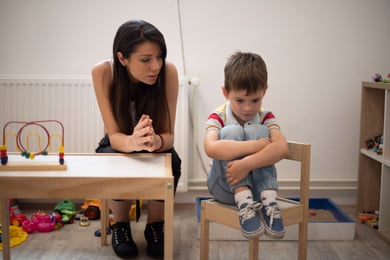Are My Child's Speech Delays a Sign of Autism?
True or False: Speech Delays = Autism?
Parents become understandably anxious when a child doesn’t meet age-expected speech development milestones. There is a delicate balance between total panic at the sign of speech delays, and taking a step-by-step approach to understanding what might be causing such delays. How can a parent know if a speech delay should be of concern, and if it might be a sign of Autism Spectrum Disorder (ASD)? As psychiatrist Steve Dvorin says, “There are so many possibilities,” regarding underlying causes.
Communication disorders comprise four separate disorders, according to the Diagnostic and Statistical Manual of Mental Disorders (DSM-V). These include:
- Language Disorder
- Speech Sound Disorder
- Childhood-Onset Fluency Disorder (Stuttering)
- and Social/Pragmatic Communication Disorder

As explained in the DSM-V,
Speech is the expressive production of sounds and includes an individual’s articulation, fluency, voice, and resonance quality. Language includes the form, function, and use of a conventional system of symbols (i.e., spoken words, sign language, written words, pictures) in a rule-governed manner for communication. Communication includes any verbal or non-verbal behavior (whether intentional or unintentional) that influences the behavior, ideas, or attitudes of another individual (p. 41, DSM-V).
Without detailing the extensive criteria for diagnoses of these four disorders, compare the above definitions of speech, language, and communication with the relevant criterion of the diagnosis of ASD (and here I am picking out only those segments that are specific to speech, language, and communication):
- Failure of normal back-and-forth conversation
- Failure to initiate or respond to social interactions
- Deficits in nonverbal communicative behaviors used for social interaction
- Poorly integrated verbal and nonverbal communication
- Abnormalities in body language
- Deficits in understanding and use of gestures (p. 50, DSM-V)
 The first essential feature of ASD (among other features), according to the DSM-V, is “persistent impairment in reciprocal social communication and social interaction” (p. 53, DSM-V). Note the emphasis on “social.” This is not quite the same as Language Disorder, which is associated with a failure of acquisition of language, primarily due to lack of comprehension. Specifically, the child with Language Disorder has a lack of word knowledge and use (vocabulary) and limited sentence structure, both of which are evident in spoken and written communication. The “social” component is not the central feature of Language Disorder, although, of course, it has an impact on social interaction; with ASD the social interaction deficit is central.
The first essential feature of ASD (among other features), according to the DSM-V, is “persistent impairment in reciprocal social communication and social interaction” (p. 53, DSM-V). Note the emphasis on “social.” This is not quite the same as Language Disorder, which is associated with a failure of acquisition of language, primarily due to lack of comprehension. Specifically, the child with Language Disorder has a lack of word knowledge and use (vocabulary) and limited sentence structure, both of which are evident in spoken and written communication. The “social” component is not the central feature of Language Disorder, although, of course, it has an impact on social interaction; with ASD the social interaction deficit is central.
While many autistic individuals are “slow to talk” (DSM-V p. 55), this in itself does not mean that an autism diagnosis is appropriate; it might be normal for that child. Symptoms of ASD are typically recognized in a child between ages 1 and 2. More subtle symptoms may require longer to recognize. Some children have a normal developmental trajectory, then rapidly and inexplicably exhibit a loss of developmental gains, such as language, before age 3; this may be a sign of ASD. After age 3, such a loss of language gains could be a sign of seizures or other specific neurological conditions.
A thorough evaluation by a medical provider is necessary to rule out any underlying medical condition that might cause a regression in language or other development and to also rule out other disorders that may have communication-related symptoms, such as Selective Mutism, Intellectual Disability, or the communication disorders mentioned above. More than one condition or diagnosis may be present at the same time. Hearing loss must also be ruled out. And, sometimes there are other quite normal reasons why a child might begin verbal communication later or on a limited basis. What do I mean by that?
 Here’s a personal example, related to the expected development of crawling and walking. I did not ever crawl, and I did not walk until age 2. Nothing was wrong with me physically, and I did not have any illness or medical condition. So why didn’t I crawl or attempt to walk? Our floor was very worn and wood splinters were waiting everywhere. As the youngest of 4 children, if my parents weren’t lugging me around, one of my older siblings was, to prevent me from getting splinters in those soft baby knees. I simply did not have the opportunity to walk until age 2. The point here is that environmental conditions are sometimes present that cause a child to develop on an alternate schedule, and these factors must be taken into account before assigning any diagnosis. Can you think of any environmental factors that might be present in your home, which could cause your child to be silent or not interactive? In many homes in the current era, children see adults staring at computer screens, scrolling across tablets, and communicating with both thumbs on cell phones. Could this cause speech-interaction delays? What do you think?
Here’s a personal example, related to the expected development of crawling and walking. I did not ever crawl, and I did not walk until age 2. Nothing was wrong with me physically, and I did not have any illness or medical condition. So why didn’t I crawl or attempt to walk? Our floor was very worn and wood splinters were waiting everywhere. As the youngest of 4 children, if my parents weren’t lugging me around, one of my older siblings was, to prevent me from getting splinters in those soft baby knees. I simply did not have the opportunity to walk until age 2. The point here is that environmental conditions are sometimes present that cause a child to develop on an alternate schedule, and these factors must be taken into account before assigning any diagnosis. Can you think of any environmental factors that might be present in your home, which could cause your child to be silent or not interactive? In many homes in the current era, children see adults staring at computer screens, scrolling across tablets, and communicating with both thumbs on cell phones. Could this cause speech-interaction delays? What do you think?
The environment can be addressed, and stimulating language learning materials may assist a child who is slow to develop communication skills. It can be difficult to know when/where to start. There is nothing wrong with using a speech-language milestones chart. But caution is advised. The American Speech-Language-Hearing Association (ASHA) states very clearly: “Children develop at their own rate.” It is easy to become anxious, and even to panic when your child is not on top of the developmental milestones. Perhaps even before calling your medical provider for an evaluation, you might try some of the steps suggested by ASHA for communication development. For your preschool or school-age child, try the Language Builder cards provided by STAGES® Learning to help your child develop early language skills.
| “The earlier the intervention, the better the prognosis will be.” |
According to psychiatrist Steve Dvorin, “The earlier the intervention, the better the prognosis will be.” So while panic is not necessary, taking reasonable investigative steps toward understanding the cause of a speech or language delay is important, as well as corrective action. Your medical provider should be consulted. If there is cause for concern, a more thorough evaluation may be required. The provider will then devise a treatment plan which will likely involve the child, parents, teachers, and potentially speech therapists or other specialists. There are many methods for addressing speech delays in a manner that builds on your relationship with your child and helps him or her develop better communication and interaction skills. So don’t panic, take it one loving step at a time.
References
American Psychiatric Association (2013). Diagnostic and Statistical Manual of Mental Disorders, 5th edition, Arlington VA.
American Speech-Language-Hearing Association, retrieved May 12, 2021 from https://www.asha.org/public/speech/development/chart/
Dvorin, S., personal communication, May 14, 2021.

Signe M. Kastberg
Signe M. Kastberg is a licensed mental health counselor with a PhD in Human Development. She taught and directed a Master’s degree program in Mental Health Counseling. She is a psychotherapist, consultant, author, certified in personality typology and is a board-certified clinical sexologist.




